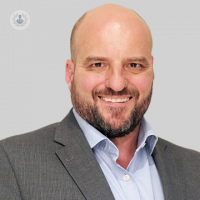Varicose veins – who gets them, and when do they need treatment?
Escrito por:An estimated 3% of the population is affected by varicose veins. But treatment has advanced enormously over the last 20 years, so we spoke to top vascular surgeon Mr Gary Maytham to find out what treatment looks like today.

What causes varicose veins?
Varicose veins occur because of failure of the valves in the affected veins.
In the legs, blood moves from the feet up towards the heart and in the veins, there are small valves which stop the blood moving back down under influence of gravity. In people with varicose veins, these small valves fail and the blood refluxes back down the veins filling the tributaries. These become engorged, enlarged and torturous and these are the veins that people describe as varicose veins.
The predominant reason for the development of varicose veins is hereditary.
It can also occur in pregnant women. The reason for this is due to the physiological changes that occurred during pregnancy. In some cases, these veins resolve after pregnancy but in others they remain.
Obesity is also associated with varicose veins, as is occupations where people spend a long time standing still.
When are varicose veins a cause for concern?
Apart from being unsightly and thus affecting a patient's quality of life, varicose veins can be associated with some significant medical problems.
The first of these is bleeding. The veins can either be damaged by some mild trauma or also because the skin overlying the veins becomes a poor quality. This can lead to some rather alarming bleeding, which may lead to you needing to go to an emergency department.
Fortunately, the bleeding is relatively easily controlled by elevation and compression. But if you have had a bleed from a varicose vein, it's highly likely that this may recur.
Secondly, the vein can become thrombosed (clotted off). This leads to inflammation around the vein which looks very much like an infection. The area becomes hot, warm and tender and is often misdiagnosed as cellulitis. It is in fact a sterile inflammation and just needs anti-inflammatories and compression for it to settle down.
The problem associated with thrombophlebitis is that if it is extensive, it is associated with the much higher risk of developing a DVT (deep venous thrombosis) than someone who does not suffer from this.
Finally, varicose veins can lead in the end stage to venous ulceration. About 3% of people who have varicose veins go on to develop venous ulcers. This is because the varicose veins affect the quality of skin around the ankles leading to even small trauma not being able to heal. Even with optimal management, treatment of venous ulcer is protracted – and may last for many months.
How are varicose veins treated?
The treatment of varicose veins has developed rapidly in the last two decades. Open surgery, although it still occurs, is very rarely indicated.
The vast majority of treatments now involve closure of the saphenous or truncal veins instead of removing them. In most cases, this is undertaken using a heat ablation technique where the heat is delivered either by a laser or radiofrequency. This is the first step of the treatment which is to treat the underlying cause.
The visible varicose veins that remain are either treated then by using injection sclerotherapy techniques or by removing them in a process called phlebectomy.
Are smaller and larger veins treated differently?
The size of the veins affecting people who have varicose veins ranges widely. This starts with the large truncal veins as previously discussed right down to the very fine thread veins which are barely visible.
The treatments of these differ:
- Large veins are treated with the endovenous thermal techniques (as previously discussed).
- As the veins get smaller, they can be treated by removing them using small incisions in a process called phlebectomy or by treating them with injections where sclerosant is injected into them.
- As they become yet smaller, the injections become finer in a process called micro sclerotherapy.
- Very small veins can also be managed with a number of different techniques such as phototherapy.


